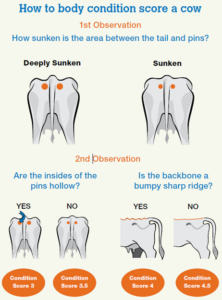The merits of Body Condition Scoring are often debated within sectors of the dairy industry, given its subjectivity and potential for variance. However, from the perspective of monitoring cow health and performance, it remains as a key factor to ongoing success.
The merits of Body Condition Scoring are often debated within sectors of the dairy industry, given its subjectivity and potential for variance. However, from the perspective of monitoring cow health and performance, it remains as a key factor to ongoing success.
BCS is essentially a visual/tactile measure of fat cover and lean muscle in mature cows. In Australia, BCS is assessed using a scale of 1 to 8, with the majority of cows falling within a range of 3 (very lightly conditioned) to 6 (over-conditioned). Each BCS equates to about 8.7% of each breed’s mature liveweight (refer to table).
|
Breed |
Mature weight |
1 BSC |
|
Jersey |
400 kg |
35 kg |
|
KiwiCross |
475kg |
41 kg |
|
Holstein (small stature): |
550 kg |
47 kg |
|
Holstein (large stature): |
650 kg |
56 kg |
Excessive BCS at calving negatively impacts on DMI and milk solids production. Over-conditioned cows (>5.5) are prone to mobilising more body fat after calving, contributing to hepatic oxidation (metabolic signals that trigger satiety) and therefore, reduced DMI. This also contributes to metabolic diseases, such as ketosis, due to an overload of fatty acids (NEFA) entering the liver relative to its capacity to oxidise them – best described as ‘fatty liver’.
As a rule of thumb, the ideal BCS at calving is 5.0–5.5 and aim to lose no more than 0.5 BSC in the first 30–40 days of lactation. To manage weight loss post-calving, strategies that both spare and optimise the production of blood glucose linked with elements (e.g. chromium) that aid tissue insulin sensitivity have proven highly successful.
Under-conditioned cows have less issues relating to hepatic oxidation and DMI, but can run into feed conversion efficiency (FCE) and reproductive challenges. The production of hormones that are essential to the resumption of the oestrus cycle are cholesterol/fat based, which directly leads into delayed calving intervals and increased inseminations per conception.
Aim to dry cows off in the BCS that you want them to calve at. Remember, it takes about 42 MJ to gain one kilogram of liveweight when cows are lactating. This increases to 58 MJ per kg of liveweight gain once she is dry, which is approaching the equivalent of 2 kg DM/day!
Regular BCS assessment allows more nuanced ration and herd management. Assessments 60 days before drying off, the day of calving and three weeks prior to mating start date can be regarded as the bare minimum. Many farmers find it beneficial to utilise an external body condition scorer to ensure an objective assessment.
If your cows need to gain BCS before drying off, increase energy density relative to the amount of metabolisable protein in the ration. High-energy, low-protein rations, such as maize silage, cereal grains and molasses can be very helpful. By-product ingredients, such as PKE, brewers grain and rice bran, that are higher in fat and provide more moderate levels of essential amino acids are also useful.
If grazing cows respond to ration changes by increasing milk production, slow down your pasture rotation and offer more conserved forage as a means of reducing the level of metabolisable protein in the ration.
If you are observing excessive variability within your herd, consider moving low BCS cows to once-a-day milking in order to reduce milk production and nutrient requirements, therefore directing more of the available nutrients towards replenishing body condition. Don’t remove them from the main herd, as they still require the additional nutrient intake to make the necessary gains.
Remember, for optimum DMI, milk solids production and reduced days to first heat next season, assess and manage your herd to achieve the ideal BCS range of 5.0–5.5 at the day of drying off.
For more information and assistance in assessing and managing BCS in your herd, contact your local CopRice advisors.

*Source: “Cow Body Condition Scoring Handbook”, © Copyright Dairy Australia 2013